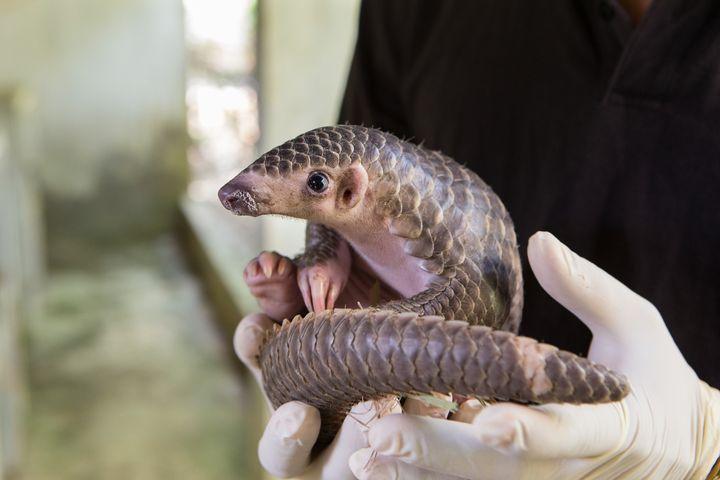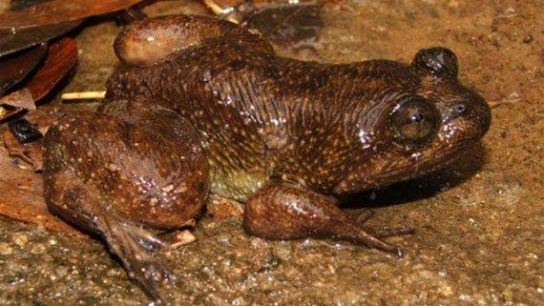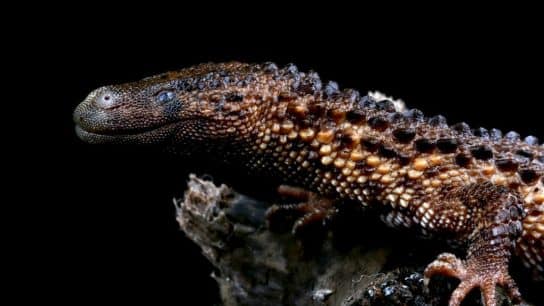The elusive pangolin, otherwise known as the scaly anteater, is a mammal that inhabits the forests and grasslands of Asia and Sub-Saharan Africa. Despite the common collective reference of “pangolins”, there are in fact eight extant species of pangolin, four of which are native to Asia: the Chinese pangolin (located across Bhutan, Nepal, Laos, Vietnam, Thailand, Myanmar, Taiwan and China); the Indian pangolin (found within India, Nepal, Pakistan and Sri Lanka); the Philippine pangolin, native to the Philippines; and the Sunda pangolin (distributed across Indonesia, Malaysia, Laos, Thailand, Myanmar, Singapore and Vietnam). Regardless of their impressive geographical range, these timid animals edge closer towards extinction with each passing day. They are amongst the most highly-trafficked species in the world, due to the futile demand for their meat and keratins-rich scales.
—
Family: Manidae
Genus: Manis
Species: Manis pentadactyla (Chinese pangolin), Manis crassicaudata (Indian pangolin), Manis culionensis (Philippine pangolin), Manis javanica (Sunda pangolin)
IUCN Status: Critically Endangered (Chinese pangolin, Philippine pangolin, Sunda pangolin), Endangered (Indian pangolin)
Population: Insufficient Data
1. Appearance
The most defining characteristic of the pangolin is its armour of scales. Constituting 20% of its body weight, these thick, keratinous, overlapping scales shield the pangolin’s entire body, apart from its underbelly which is sparsely covered with tufts of hair. Infant pangolins begin with pale, soft scales, which start hardening on their second day of life. Once fully matured, scales vary in shades of brown and yellow, although Sunda pangolins occasionally sport ‘white’ tail scales for reasons unknown. Similarly to our own nails and hair, a pangolin’s scales will also continue growing throughout its life; filing down the edges occurs naturally by virtue of the animal’s habit of digging burrows and tunnelling underground. Whilst Asian and African pangolins share many similar physical characteristics, a distinguishing feature possessed solely by Asian pangolin species is thick hairs, or bristles, between their scales. Amongst Asian pangolins, each species varies slightly in the size, quantity, bodily distribution and colour of their scales.
The Chinese pangolin, Manis pentadactyla. Photo by Sarita Jnawali for the Pangolin Specialist Group
Asiatic pangolin species also differ slightly in body size, with Indian pangolins proving to be the largest of the group at 84-122 centimetres in length, and 10 to 16 kilograms in weight. Indian pangolins also have the largest scales and longest claws of the four species. Chinese pangolins average a length of 48-58 centimetres, and a weight of 1.8 to 7 kilograms, whilst Sunda pangolins can reach a length of 122 centimetres and a weight of 10 kilograms.
2. Diet
Pangolins are insectivores and feast primarily on a diet of ants and termites, supplemented by a variety of other invertebrates (bee larvae, worms, flies, and crickets). As nocturnal hunters with poor vision, pangolins rely on their advanced olfactory sense to locate prey. However, with small heads, long snouts, and brawny front claws, they are able to excavate mounds, stumps and fallen branches with ease. Furthermore, due to a lack of teeth, pangolins have spectacularly long, powerful, sticky tongues used for lapping up insects within deep cavities. These gluey appendages can reach up to half the length of the pangolin’s body. Since pangolins cannot chew their food, these incredible creatures have developed a specialised stomach that aids with their digestion. The pangolin’s stomach is lined with keratinous spines which, when paired with a few stones purposefully swallowed by the animal, crushes and grinds their prey in a similar fashion to a bird’s gizzard. To avoid troublesome ants entering through any facial cavities, or to prevent termites from escaping their fate, pangolins have also developed specialised muscles in their ears and noses to seal them shut when digging.
Their dietary selectivity makes these scaly creatures difficult to keep in captivity, as they will often reject foreign species of insects or fall ill when fed unfamiliar food.

3. Habitat and Behaviour
Pangolins are known to inhabit a wide range of vastly diverse habitats, including: primary and secondary forests; grasslands; bamboo forests; arid savannahs; scrublands; mangroves; riverine forests; villages; palm oil and rubber plantations; and agricultural fields. As a consequence, pangolins are believed to adapt relatively well to anthropogenic pressures, settling in artificial, degraded habitats where sources of prey remain plentiful. Nevertheless, further research into the capacity of these Pangolin species to survive within inhospitable environments long-term is required. The habitat in which pangolin populations thrive most is primary forestland, due to the abundance of old, hollow trees for resting, ants nests, termite mounds, fresh water, and a lack of human activity.
Pangolins are nocturnal, solitary animals that spend the majority of their waking hours in search of food and shelter. These clawed creatures dig large burrows, up to 10 metres in depth, which they use for sleeping and mating. Alternatively, they enlarge existing termite burrows after excavating a mound and consuming its inhabitants. Some pangolins have been known to excavate up to 15 prey sites per night. Opportunistically arboreal in nature, pangolins also utilise their strong, semi-prehensile tails to climb trees in order to seek shelter in hollow trunks or to access ants nests. In fact, Indian pangolins inhabiting the tropical rainforests of Sri Lanka spend most of their time in the canopy, where the growth of fruit and flowers attracts colonies of ants. Pangolins are also surprisingly good swimmers, and can sometimes be seen taking a leisurely dip. Whilst both males and females tend to roam solitarily when not mating, females with offspring nurse their young for approximately three to four months.
Although relatively small in stature, or perhaps as an evolutionary consequence of their size, pangolins possess an incredibly effective defence mechanism against predators. When frightened, pangolins roll up into a ball, thereby protecting their unscaled bellies and exposing their razor-sharp scales to any nearby threats. This characteristic defensive strategy perhaps inspired the nomenclative history of the species, as the word “pangolin” originates from the Malay word “pengguling”, meaning “something that rolls up”. A pangolin will also utilise its tail extensively as a weapon, lashing out at undeterred attackers and often inflicting serious injuries. As a last line of defence, these soldierly animals are able to emit a foul, noxious acid from a gland below their tails to ward off any remaining predators.
4. Ecosystem Services
By virtue of their exclusive dietary preferences and tendency to dig, pangolins provide two key services to their surrounding ecosystems: soil maintenance and population control.
The pangolin’s unwavering appetite for termites and ants, as well as other insects and larvae, assists with the regulation of insect populations within several Asian countries. Pangolins are believed to consume approximately 70 million insects per annum, equating to almost 200,000 insects per day. This laborious feat contributes greatly to the balance of the ecosystem, establishing equilibrium within the food chains of several different environments.
As aforementioned, pangolins habitually dig burrows for sleeping and mating, as well as for excavating ants nests and termite mounds. This regular disturbance of soil aids with soil aeration, similar to the effect of plowing crop fields. Aeration of soil is necessary to prevent the build up of compacted soil, which inhibits the circulation of water, nutrients and air. By digging up subsoil and overturning topsoil, pangolins naturally facilitate the nutrient cycle and contribute to the growth of healthy vegetation. Abandoned burrows also provide shelter and habitat for other animals.
5. Threats
Very little is known about pangolin population demographics, due to the insufficiency of scientific research conducted on the mammal. Yet, three Asian pangolin species (Chinese, Philippine, and Sunda) are currently classified as ‘Critically Endangered’ under the International Union for Conservation of Nature (IUCN) Red List, whilst the Indian pangolin is categorised as ‘Endangered’. This precautionary assessment is predominantly based on a number of factors.
The first, and most substantiating, is the apparent overexploitation of pangolins from illicit hunting and poaching. This conclusion is supported by the extremely high levels of trafficking witnessed throughout Asia, with the frequent interception of live, dead, or deconstructed pangolins within key consumer countries. Over the past decade, over one million pangolins have been poached for commercial use, which is more than the combined total of trafficked elephants, tigers, and rhinoceroses. However, this is believed to be a conservative figure, given that approximately 195,000 pangolins were trafficked solely for their scales in 2019. Many speculate that police confiscations only account for 10% of pangolins traded on the black market. Studies conducted in 2019 suggest that a pangolin is poached every three to five minutes worldwide.
At present, China and Vietnam stand as the primary importers and consumers of pangolin, although research shows an increased demand in the Americas for pangolin skin in the production of leather clothing products. Within Asia, pangolin meat is considered a delicacy and is worth approximately USD$350 in restaurants across Vietnam. Meanwhile, pangolin scales are believed to hold ethereal medicinal properties in traditional Asian remedial practices, and are used to treat a wide variety of illnesses from cancer and asthma to rheumatism and arthritis. Pangolin scales are even covered under certain health insurance schemes in Vietnam, as well as in China.
Originally, Asian pangolin species bore the brunt of the trafficking trade, as demands were highest on the continent. Nevertheless, due to the rapid decrease in pangolin populations across Asia, trader focus has shifted significantly towards African species to meet the incessant demand for meat and scales. In 2019, a shipment containing 8,300 kilograms of pangolin scales was seized in Hong Kong, having arrived from Nigeria. Within the same year, a similar report arose in Singapore as two Nigerian shipments were intercepted, each containing approximately 12,700 kilograms of pangolin scales. A report released in 2020 by the United Nations Office on Drugs and Crime indicated that 71% of pangolin scale seizures were on route to China.

The demand for pangolins has yet to subside, largely due to the incredibly high financial value of the animal and its derivatives. In India, the price of scales has continued to increase substantially over the past 20 years. There is little evidence to suggest that demand reduction strategies in Asian countries are effective, especially given the weak enforcement of trafficking laws in key consumer countries, as well as in primary export and transit locations. Myanmar, Laos and Thailand play a significant part as transit countries for the trade of pangolins since all three regions lack the governmental transparency and legal resources necessary to effectively curb the market. These issues are compounded by the fact that the pangolin is a relatively easy target for poachers, given their complete immobility once frightened.
A second factor is the rapid and unrelenting pattern of deforestation across numerous Asian countries, posing a threat to the integrity of potential pangolin habitat. As aforementioned, there has been little scientific research conducted on the habitat preferences of pangolins within Asia. The Sunda pangolin has been known to adapt well to wetland ecosystems, and the Indian pangolin has been recorded inhabiting incredibly arid regions, as well as anthropogenically degraded areas. It is thus difficult to say with complete certainty that deforestation has directly impacted pangolin populations. However, this uncertainty alone warrants further investigation into the ability of pangolins to thrive long-term in such inhospitable environments as rubber and palm oil plantations.
Regardless of the direct culpability of deforestation, the inherent clearing of trees frequently opens up areas of land previously inaccessible to hunters and poachers, as well as to agricultural developers who regularly pollute sources of pangolin food with pesticides. The decreasing availability of luxury wood in countries such as Cambodia further incentivises loggers to focus their efforts on more lucrative sources of income, such as the poaching of pangolins. Infrastructural projects which fragment forested areas, such as the building of roads, also expose pangolins to the risk of traffic accidents.
A third factor supporting the pangolin’s precautionary ‘Critically Endangered’ status is the inherent difficulty associated with studying their population dynamics, as well as their ecological and behavioural traits. The general lack of scientific data on the various species has greatly compounded the inadequacy of conservation strategies, which are already contending with the incentives of a multimillion dollar black market trade. Strategies for habitat loss, poaching and conflict-management are rendered futile without a detailed understanding of the pangolin’s habitat preferences, population densities, tolerance to anthropological pressures, migratory patterns, and ecological characteristics. Results from recent biodiversity surveys demonstrate the ineffectiveness of conventional monitoring techniques, such as counting burrows, as pangolins have been proven to dig multiple burrows in a short time span. Such elusive creatures require methodology designed specifically for detection, thereby alerting us to the true extent of the pangolin’s plight and hopefully providing some insight into effective conservation schemes.
6. Conservation Efforts
In 2016, a significant yet overdue step was taken in the field of pangolin conservation, as all eight species were added to Appendix I in the Convention on the International Trade in Endangered Species of Wild Fauna and Flora (CITES). This prohibits the international trade of pangolins for commercial use. Although many national legislative measures banning the illegal capture, consumption and trade of pangolins predated the amendment of CITES, it was hoped that the international ban would instill a degree of accountability which was noticeably absent from national enforcement tactics.
Nevertheless, the treaty has thus far been unsuccessful. The demand for pangolin meat and scales continues to grow annually, and key consumer countries remain unregulated. Although there has been an increase in cases of confiscated pangolin products, this fact is likely indicative of the increase in demand and trade. Furthermore, issues of jurisdiction frequently allow traffickers to escape liability and prosecution when shipments are intercepted.
In 2020, China updated its national legislation to purportedly close a significant loophole, which previously allowed for the consumption of pangolin meat within China. The legislative changes also claimed to prohibit the use of pangolin scales in traditional medicinal practices. However, studies conducted in mid-2020 by the Environmental Investigation Agency indicated that Chinese pharmaceutical companies, such as the Beijing Tong Ren Tang Group, and popular online platforms, such as eBay and Taobao, continued to advertise and sell pangolin products after the legislative changes. It was discovered that 221 companies were licensed to sell products containing pangolin scales, which were distributed from certified “national stockpiles”.
It is thus clear that the enactment of national and international legislative measures is not enough to reduce the trafficking of pangolins. Of equal importance are novel methods of regulating national markets, as well as effective strategies aimed at changing consumer behaviour and eliminating incentives for poaching. Campaigns and partnerships organised by numerous NGOs successfully raise awareness of the illegal pangolin trade, garnering more international media attention with each passing year. Sniffer dogs trained by wildlife conservation organisations are increasingly deployed to key airports, shipping ports and other known trade hubs to intercept illegal trafficking. Community education and outreach programs in villages and towns across Asia advise against the hunting and poaching of pangolins, as well as providing the tools necessary for sustainable agriculture as an alternative source of food and income. Wildlife authorities patrolling protected areas are increasingly trained in investigating and apprehending poachers. Various rescue centres have been established across Asia for the protection and rehabilitation of live pangolins seized by police. Lastly, scientific research and data collection initiatives conducted by various conservation groups are aimed at determining the population demographics of each pangolin species, as well as uncovering key ecological and behavioural traits possessed by pangolins which could assist with the development of effective conservation strategies.
The start of 2020 presented a potential, yet somewhat unconventional, silver lining in pangolin conservation with the onset of the Covid-19 pandemic. Despite our then limited understanding of the virus and its effects, scientists wasted no time in tying the rampant trafficking of pangolins in China to the initial outbreak of the disease in the region. In early February of 2020, speaking at a press conference in Guangzhou, two scientists claimed to have tested coronaviruses from humans and pangolins with results indicating a similarity of 99% between the genetic sequences of each virus. These claims were later partially recanted with the release of a preliminary version of the investigation, which stated that the pangolin virus was “unlikely to be directly linked to the outbreak because of the substantial sequence differences”.
Nevertheless, by the end of February 2020, the Chinese government had announced a ban on the trade and consumption of various animals, including the pangolin. Markets specialising in the sale of wild animals were also shut down in an attempt to curb the spread of the virus. It is unclear whether these fear-induced measures will influence the overall trade of pangolins, since the market has largely shifted to importing scales for pharmaceutical products. Nevertheless, NGOs such as WWF have cited the health crisis as a “wake-up call to end the unsustainable use of endangered animals and their parts, whether as exotic pets, for food consumption or for their perceived medicinal value.”
NGO Spotlight
One organisation at the forefront of pangolin protection initiatives is the Pangolin Crisis Fund (PCF), managed by the Wildlife Conservation Network and the Save Pangolins group. The PCF provides grants to numerous projects aimed at streamlining conservation strategies through hands-on community service and research-based work. These include: locating pangolin strongholds or habitats where species recovery potential is high, and protecting these key sites through collaborations with NGOs, governments, and local populations; conducting education campaigns in Palawan and assisting in improving the socio-economic conditions of farmers; engaging local Indonesian communities in conservation projects, such as establishing patrols of forested areas to prevent poaching; and investigating the pangolin trade in various key consumer countries to inform international conservation initiatives to the reality of the situation. The incredible work performed by organisations such as the Pangolin Crisis Fund are instrumental in the campaign against pangolin extinction.

What Can You Do To Help?
- Donate or volunteer with a pangolin conservation group. There are several organisations working incredibly hard to protect pangolins worldwide through lobbying campaigns, fundraising events, research initiatives and community outreach programmes. Get in touch with your local wildlife conservation group and see what you can do to help.
- Raise Awareness. The illegal pangolin trade has amassed a significant amount of international media attention over the past few years, however consumer demands for pangolin products have yet to decrease and governments continue to falter with enforcing legislative measures. Inform your local community of the pangolin’s plight and lobby your government to hold CITES signatories accountable for their actions.
- Avoid purchasing pangolin products. Be sure that any handbags, belts and accessories that you buy are not made with pangolin scales. Certain medicinal products manufactured in China or Vietnam may also contain powdered pangolin scales, so make sure to read the label first.
Featured image by: Gerald Cubitt for the Pangolin Specialist Group
If you want to learn more about endangered species, make sure to check out other articles from our Endangered Species Spotlight Series




















